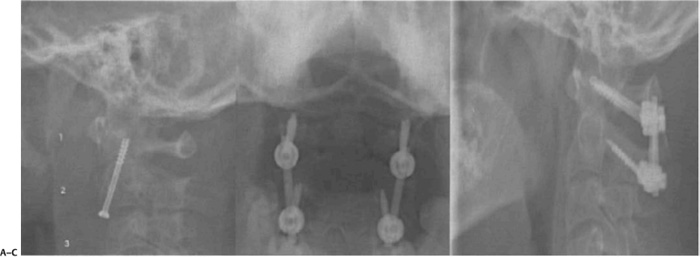

Initially described by Böhler, 16 osteosynthesis with 1 or 2 screws by an anterior approach is standard operative treatment in younger patients with good bone quality if adverse modifiers are absent ( Table 2). Magnetic resonance imaging (MRI) can give information about age of the fractures, ligamentous injuries, and status of the myelon. Flexion-extension X-rays guided by hand may give more information about potential instability. Multislice computed tomographic (CT) scans with multidirectional reconstructions have to be performed in the “high-risk” group as it allows to evaluate fracture type and to assess the degree of instability in polytraumatized patients and after high-energy trauma. Conventional X-rays in 2 planes in combination with a special transoral view are still standard diagnostics for patients in the “low-risk” group with a suspected cervical spine injury after blunt trauma. 7 With a detailed history and physical examination patients in the low-risk group can be cleared without further radiographic examinations. Canadian C-Spine rules are recommended due to their high sensitivity. Patients history and clinical examination is documented by using a structured protocol, neurological deficits have to be documented using the scoresheets of the American Spinal Cord Injury Association (ASIA, ). The Spine Section of the German Society for Orthopaedics and Trauma (Deutsche Gesellschaft für Orthopädie und Unfallchirurgie, DGOU) has set up a working group to analyze strategies in German trauma and spine centers and is going to publish recommendations on the treatment of odontoid fractures. The optimal treatment remains controversial as there are many contributing factors. Despite numerous published articles over the past 2 decades. 3 In younger patients, the potential loss of C1/2 motion should be taken into account, thus anterior direct osteosynthesis or temporary posterior stabilization using Harms technique are better options in this patient group. 5, 6 In a recently published meta-analysis, posterior C1/2 fusion resulted in significantly higher fusion rates in the elderly. 1, 4 However, even operation results in nonunion rates of up to 33%. 3 Initially strong indications with fracture displacement >5 mm, angulation >10°, and the presence of neurological deficits are widened also considering the potentially high morbidity, instability and secondary displacement in conservatively treated patients. Management options for odontoid fractures have expanded with advantages in imaging and surgical technologies, with a trend toward primary operative stabilization. Injury treatment aims to reestablish stability of the atlanto-axial complex. 2 This fracture type is potentially serious due to the proximity of the medulla oblongata and the great mobility of the cranial-cervical junction resulting in a high risk of life-threatening neurological lesions. 1 In the elderly population, this fracture type represents the most common cervical spine fracture and in the population older than 80 years, the most common spine fracture of all.

Odontoid fractures are widely common and reported to account for up to 15% of all cervical spine injuries. As there is still some bias in the treatment algorithms, the working group recommends establishment of a prospective study to result in more objective statements. In the aged population (>80 years), operative therapy is critical as postoperative morbidity complication and mortality rates rise significantly.

In these cases, posterior instrumentation or fusion of C1 and C2 is favorable. The technique is demanding and leads to elevated complication and failure rates if modifiers are apparent. Unstable and/or dislocated displaced odontoid fractures are treated by anterior osteosynthesis with 1 or 2 screws. Stable odontoid fractures are treated conservatively non-operatively, but if so regular controls have to be performed. To create an adequate treatment algorithm, dislocation displacement and instability have to be identified. The classification of Anderson and D’Alonzo is still standard. If operation is indicated, many influencing factors have to be considered for appropriate approach and technique. Conservative treatment may also be started within stable nondislocated fractures, but then regular controls have to be performed. However, in the aged population, conservative treatment should be considered as morbidity and mortality rise significantly in the group of >75 years. Operation seems to be standard treatment for odontoid fractures.


 0 kommentar(er)
0 kommentar(er)
